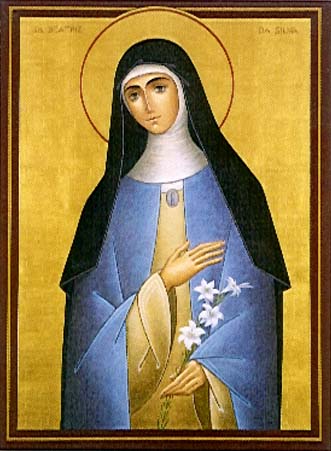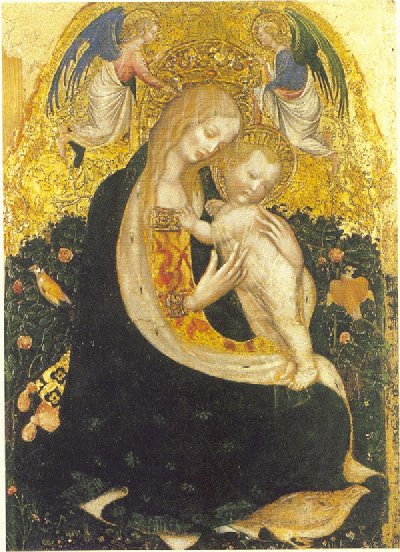
축일:2월26일
프랑스츼 복녀 이사벨라
Blessed Isabella of France
Beata Isabella di Francia
Beata Isabella di Francia Principessa
1225 - 23 febbraio 1270
Beatified :1520 by Pope Leo X
Canonized :pending
Name Meaning:dedicated to God(하느님께 바치는)
Patronage :sick people
성 루이 왕(성왕 루도비코)의 동생이자 루이 8세의 딸인 그녀는
여러 곳의 혼처를 거부하고, 하느님께 동정을 서원하였다.
그녀는 주로 병자와 가난한 사람들을 돌보던 중, 그녀의 모친이 사망한 뒤에는
파리의 롱샹프에 프란치스칸 수도원(클라라회)을 세우고,
엄격한 수도생활에 전념하였으나, 수녀가 되지는 않았고, 더우기 원장은 한사코 거절하였다.
매우 겸손하셨으며 극기와 희생으로 온생애를 기도하며 살았다.
(성바오로수도회홈에서)
성 루도비쿠스(Ludovicus, 8월 25일) 왕의 동생이자 루이 8세의 딸인 성녀 이사벨라는 여러 곳의 혼처를 거부하고 하느님께 동정을 서원하였다. 그녀는 주로 병자와 가난한 사람들을 돌보던 중 그녀의 모친이 사망한 뒤에는 파리(Paris)의 롱샹(Longchamps)에 성녀 클라라의 수도규칙을 따르는 수도원을 세우고 엄격한 수도생활에 전념하였으나 수녀가 되지는 않았다. 더욱이 원장직은 한사코 거절하였다. 그녀는 1270년 2월 롱샹의 수도원에서 선종하여 그곳 성당에 묻혔다. 그녀에 대한 공경은 1521년 교황 레오 10세(Leo X)에 의해 승인되었고, 1688년에는 수녀들이 8일 축제와 함께 2월 25일에 축일을 기념하도록 허가되었다. 현재 전체 프란치스코회 수도원에서는 9월 1일에 성녀의 축일을 기억하고 있다. 성녀 이사벨라는 이사벨(Isabel)로도 불린다.(가톨릭홈에서)

축일:9월1일(8월16일)
실바의 성녀 베아트리체
Santa Beatrice de Silva Meneses Fondatrice
St. Beatrice da Silva Meneses
Ceuta (Nord Africa), ca. 1424 - Toledo (Spagna), 16 agosto 1491
Born :1424 at Cueta, Portugal
Died :1 September 1490 at Toledo
Beatified :1926 by Pope Pius XI (cultus confirmed)
Canonized :1976 by Pope Paul VI
*9월1일 실바의 성녀 베아트리체 동정(게시판1343번)
☞http://home.catholic.or.kr/gnbbs/ncbbs.dll/chinchang

성왕 루도비코
축일:8월25일.게시판1331번.
☞http://home.catholic.or.kr/gnbbs/ncbbs.dll/chinchang
프랑스 국왕 루도비코 9세(1215 - 1270)는 빠리 근처 뽜시 출생으로 12 살에 왕이 되었다.
젊은 시절 프란치스칸 교사들로 부터 교육을 받았고 후에 3회에 입회하였다.
그는 모범적인 왕이요 남편이자 아버지이고 그리스도인이었다.
그는 현명하고 공정하게 나라를 다스렸다.
특히 가난한 사람들과 성직자들의 궁핍에 깊은 관심을 보였다.
십자군 원정 중 성지에서 사라센인들에게 포로가 되었으며
석방되자 프랑스에 돌아와서 자신의 나라를 다스렸다.
두 번째 십자군 원정 중에 병든 병사를 간호하다 전염된 역병으로 세상을 마쳤다.
재속프란치스코회의 주보 성인이다.
(작은형제회홈에서)


겸손한 마리아-피사넬로(Pisanello)
1420∼22년. 50cm ×33㎝. 베로나.카스텔베키오 미술관
북 이탈리아 초기 르네상스의 중요한 미술가로 손꼽히는 피사넬로는
풍속화적 경향을 띤 독자적 양식을 만들어 내었다.
특히 동물들이나 식물에 깊은 애정을 가졌는데 그것들이 그의 화면 구성에 있어서 중요한 역할을 맡고 있다.
메다이유(Medaille)조각사로서 귀금속이나 구리를 재료로 하고 주조(鑄造)
혹은 각인(刻印)하여 기념비, 메달, 상패를 만들어 최초의 대표적인 메다이유 작가가 되기도 하였다.
마리아 도상의 흐름을 보면 초대 교회부터 중세까지의 성모상은
대체로 엄격한 신성을 강조한 것이 특징이었다.
그리하여 초대 교회부터 13세기까지 중세의 성모자상은
보통 성모 마리아가 아기 예수님을 안고 화려한 옥좌에 앉아 있는 형상이 주를 이룬다.
아기 예수님은 성인의 비례로 그려졌으며 크기만 작을 뿐
어른의 축소판과 같은 모습을 하고 있는 경우가 많았다.
아기 예수님을 성인의 모습으로 그린 것은 전능하고 완전한 하느님의 모습으로 나타내려고 하였기 때문이다.
이 때의 예수님을 보면 팔을 들어 올린 승리자 혹은 심판자의 모습을 하고 있다.
그들이 앉아 있는 옥좌가 유난히 크고 화려한 이유는 그것이 교회를 상징하였기 때문이다.
마리아상의 변화는 사회변화에 따른 종교와 미술의 변화로 해석할 수 있다.
유럽의 다른 나라에 비해 일찍부터 도시와 상업이 발달했던 이탈리아에서는
사람들의 사고가 현실적, 이성적으로 변해가고 있었다.
신앙도 천상에서의 구원을 비는 데 만족하지 않고, 지상에서의 행복을 추구하게 되었다.
이 때부터 성서 이야기는 현실 속으로 들어와 삶의 자리를 찾게 되었다.
이를테면 마리아가 화려한 옥좌에서 내려와 아예 땅에 앉은 유형도 탄생하게 되었다.
이 같은 마리아를‘겸손한 마리아'라고 부른다.
마리아가 아기 예수님을 안고 얼굴을 자신의 뺨에 비비며 애틋한 모정을 표현하고 있는 이 장면은
어머니가 어머니가 되기 위한 가장 아름다운 점이다.
‘겸손하신 동정녀시여! 저희를 위하여 빌어 주소서.’
(정지풍 신부)
♬두메꽃-시.최민순신부
2010.2.24. update
Beata Isabella di Francia Principessa
22 febbraio
1225 - 22 febbraio 1270
Figlia del re Luigi VIII e di Santa Bianca di Castiglia, sorella di san Luigi IX. Educata dalla madre con una profonda e severa religiosità, fin dall'infanzia si distinse per la profonda pietà. Una lunga malattia fece maturare in lei la decisione di dedicarsi alle sue pratiche di pietà, alle pie letture e alla cura dei poveri. Si distinse in modo particolare per il culto alle reliquie dei santi e per il mantenimento dei crociati. Dopo aver rifiutato molte proposte di matrimonio e successivamente alla morte della madre, con l'aiuto del fratello, fonda un monastero a Longchamp presso Parigi, poi distrutto durante la Rivoluzione francese. Non adottò la regola di S. Chiara, ma per andare incontro alla comunità di religiose di nobile origine scrisse una regola che mitigava il voto di povertà. Tale regola fu approvata nel 1263 da papa Urbano IV e fu adottata da altri monasteri di Clarisse, specialmente in Francia. Visse santamente a Longchamp sino alla morte avvenuta dopo due anni di malattia. Sepolta inizialmente nella chiesa del convento, ora le sue reliquie sono a Parigi presso la tomba di San Luigi IX e in parte nella cattedrale di Meaux.
La principessa Isabella, sorella minore del re San Luigi IX di Francia, nacque nel 1225 dal re Luigi VIII e dalla regina Santa Bianca di Castiglia. La principale fonte circa la vita di questa beata è la “Vita” scritta da Agnese di Harcourt, badessa del monastero di Longchamp fondato dalla stessa Isabella, che si occupò di lei negli ultimi dieci anni della sua vita. E’ difficile a distanza di così tanto tempo discernere se le sue scelte di vita quali il rifiuto del matrimonio e del cibo, comuni a numerose altre ragazze di un tempo, fossero dettate da convinzioni spirituali e da libere scelte, piuttosto che da elementi patologici, psicologici o politici. Sin dall’adolescenza Isabella nutrì una repulsione verso la sua condizione regale, disprezzando il lusso che la circondava e cadendo in una profonda anoressia, al punto che alla madre per tentare di aiutarla non restò che appellarsi ad una “donna santa”. Costeì si limitò però a fare una profezia, cioè che la giovane principessa sarebbe ancora vissuta come “morta al mondo”. In seguito rifiutà non pochi pretendenti ed al papa Innocenzo IV, che le aveva scritto affinchè accettasse la mano del re Corrado di Gerusalemme per il bene della cristianità, rispose con fermezza negativamente, chiedendo piuttosto con risolutezza ed ottenendo di poter emettere il voto perpetuo di verginità.
Nel 1226 era asceso al trono suo fratello, che si rivelò per lei ispiratore della carità verso i poveri e del fervore religioso: quotidianamente infatti Isabella era solita invitare alla sua mensa numerosi mendicanti e visitava malati e poveri. Luigi prese parte a due crociate, risultate però inefficaci, e quando nella prima fu fatto prigioniero in Egitto, per Isabella fu un duro colpo, giàcche sovvenzionava il sostentamento di dieci cavalieri per contribuire al recupero dei luoghi santi. Altra figura influente nella sua vita fu Santa Chiara d’Assisi e nel 1252, alla morte della madre, Isabella decise di fondare a Longchamp un convento ove vivere secondo gli ideali delle clarisse: re Luigi approvò e finanziò tale progetto ed alcuni francescani, fra cui San Bonaventura, furono chiamati a collaborare alla formulazione della regola e delle costituzioni. Il nuovo monastero, sito nei sobborghi parigini, fu dedicato all’Umiltà della Beata Vergine Maria.
Da allora Isabella profuse buona parte delle proprie sostanze a sostegno del convento e proseguì la sua attività di assistenza ai poveri. Assai probabilmente, ella però non emise mai i voti perpetui, forse a motivo delle sue precarie condizioni di salute: la stessa sua decisione di vivere in un luogo separato dell’edificio, non a stretto contatto con le celle delle suore, fu dovuta a quanto pare a motivi di umiltà uniti al desiderio di scongiurare l’eventuale elezione a badessa. Per dieci ani condusse in monastero una vita di digiuno, penitenza, contemplazione e preghiera. Prima della sua morte, avvenuta il 22 febbraio 1270, il suo cappellano, il confessore e suor Agnese, suo futura biografa, furono testimoni di un suo rapimento estatico. Pochi mesi dopo morì a Tunisi il suo santo fratello, di ritorno dalla seconda crociata.
Papa Leone X, con bolla pontificia del 3 gennaio 1521, dichiarò “beata” la principessa Isabella di Francia, una delle prime sante clarisse. Un tempo la sua festa era celebrata dall’ordine francescano all’8 giugno insieme alle consorelle Agnese di Boemia e Camilla Battista da Varano. Luigi IX fu invece uno dei primi terziari francescani ad essere riconosciuto santo.
Autore: Fabio Arduino
_______________________
Aggiunto il 21-Feb-2007
Letto da 4141 persone
ISABELLA of France
Also known as
Isabel of France; Isabella of France
Memorial
26 February
Profile
Daughter of Blanche of Castile. Only sister of Saint Louis IX. Declined marriage offer from the German emporer in order to found a Poor Clare convent at Longchamps near Paris, where she lived as a nun, though without taking vows.
Died
1270
Beatified
1520
Canonized
pending
Name Meaning
dedicated to God
Patronage
sick people
Beata Isabella di Francia
25 giugno (o 23 febbraio)
1225 - 23 febbraio 1270
Figlia del re Luigi VIII e di Bianca di Castiglia, sorella di san Luigi IX. Nasce nel 1225 e muore il 23 febbraio 1270. Educata dalla madre Bianca con una profonda e severa religiosita, fin dall'infanzia si distinse per la profonda pieta.
Una lunga malattia fece maturare in lei la decisione di dedicarsi alle sue pratiche di pieta, alle pie letture e alla cura dei poveri. Si distinse in modo particolare per il culto alle s. reliquie dei Santi e per il mantenimento dei crociati. Dopo aver rifiutato molte proposte di matrimonio e successivamente alla morte della madre, con l'aiuto del fratello, fonda un monastero a Longchamp presso Parigi (distrutto dalla Rivoluzione francese). Non adotto la regola di S. Chiara, ma per andare incontro alla comunita di religiose - di nobile origine - scrisse una regola che mitigava il voto di poverta. Tale regola fu approvata nel 1263 da papa Urbano IV e fu adottata da altri monasteri di Clarisse, specialmente in Francia.
Visse santamente a Longchamp sino alla morte avvenuta dopo due anni di malattia. Sepolta inizialmente nella chiesa del convento, ora le sue reliquie sono a Parigi presso la tomba di San Luigi IX e in parte nella cattedrale di Meaux.
Non e chiaro se la beata Isabella abbia mai professato i voti nel Secondo Ordine francescano, anche se i francescani la considerano appartenente al loro Ordine.
Due memorie liturgiche: a Parigi il 25 giugno, mentre nel martirologio Francescano il 23 febbraio.
Autore: Don Marco Grenci
Blessed Isabella of France
Blessed Isabella was a princess in France in the 13th Century. Although she lived many years in the royal palace - her life was modeled after that of a religious. She fasted three days a week, ate little at other times and was devoted to a life of penance and prayer. Many in the court considered her to be a saint even at that time, one of the court ladies described her as, "a mirror of innocence, and at the same time an admirable model of penance, a lily of purity, a fragrant rose of patience and self-renunciation, and endless fountain of goodness and mercy."
After the death of her mother she desired to withdraw to a convent. Her brother, King Louis (whom she dearly loved) wanted her to marry as well as Emperor Frederick II who wanted her to marry his oldest son, Conrad. Even Pope Innoncent IV encouraged her to marry - but Isabella's heart was steadfast in desiring to lead a more religious life. There-upon the pope praised her for her noble sentiments and gave her his fullest reccomendation and her brother, King Louis assisted her in building a convent for the Poor Clares at Longchamps near Paris.
She lived for nine years in the convent (although she did not take vows to become a Poor Clare) - she lived an exemplary life - in humility and love. At the time of her death in 1270 several attested to hearing Angels singing to her and welcoming her into heaven.
Text & picture by Sister Patricia Proctor, osc
St. Isabel of France
Daughter of Louis VIII and of his wife, Blanche of Castille, born in March, 1225; died at Longchamp, 23 February, 1270. St. Louis IX, King of France (1226-70), was her brother. When still a child at court, Isabel, or Elizabeth, showed an extraordinary devotion to exercises of piety, modesty, and other virtues. By Bull of 26 May, 1254, Innocent IV allowed her to retain some Franciscan fathers as her special confessors. She was even more devoted to the Franciscan Order than her royal brother. She not only broke off her engagement with a count, but moreover refused the hand of Conrad, son of the German Emperor Frederick II, although pressed to accept him by everyone, even by Pope Innocent IV, who however did not hesitate subsequently (1254) to praise her fixed determination to remain a virgin. As Isabel wished to found a convent of the Order of St. Clare, Louis IX began in 1255 to acquire the necessary land in the Forest of Rouvray, not far from the Seine and in the neighbourhood of Paris. On 10 June, 1256, the first stone of the convent church was laid. The building appears to have been completed about the beginning of 1259, because Alexander IV gave his sanction on 2 February, 1259, to the new rule which Isabel had had compiled by the Franciscan Mansuetus on the basis of the Rule of the Order of St. Clare. These rules were drawn up solely for this convent, which was named the Monastery of the Humility of the Blessed Virgin (Monasterium Humilitatis B. Mariæ Virginis). The sisters were called in the rule the "Sorores Ordinis humilium ancillarum Beatissimf Marif Virginis". The fast was not so strict as in the Rule of St. Clare; the community was allowed to hold property, and the sisters were subject to the Minorites. The first sisters came from the convent of the Poor Clares at Reims. Isabel herself never entered the cloister, but from 1260 (or 1263) she followed the rules in her own home near by. Isabel was not altogether satisfied with the first rule drawn up, and therefore submitted through the agency of her brother Louis IX, who had also secured the confirmation of the first rule, a revised rule to Urban IV. Urban approved this new constitution on 27 July, 1263.
The difference between the two rules consisted for the most part in outward observances and minor alterations. This new rule was also adopted by other French and Italian convents of the Order of St. Clare, but one can by no means say that a distinct congregation was formed on the basis Isabella's rule. In the new rule Urban IV gives the nuns of Longchamp the official title of "Sorores Minores inclusæ, which was doubtlessly intended to emphasize closer union with the Order of Friars Minor. After a life of mortification and virtue, Isabella died in her house at Longchamp on 23 February, 1270, and was buried in the convent church. After nine days her body was exhumed, when it showed no signs of decay, and many miracles were wrought at her grave. In 1521 Leo X allowed the Abbey of Longchamp to celebrate her feast with a special Office. On 4 June, 1637, a second exhumation took place. On 25 January, 1688, the nuns obtained permission to celebrate her feast with an octave, and in 1696 the celebration of the feast on 31 August was permitted to the whole Franciscan Order. They now keep it on 1 September. The history of the Abbey of Longchamp had many vicissitudes. The Revolution closed it, and in 1794 the empty and dilapidated building was offered for sale, but as no one wished to purchase it, it was destroyed. In 1857 the walls were pulled down except one tower, and the grounds were added to the Bois de Boulogne.






